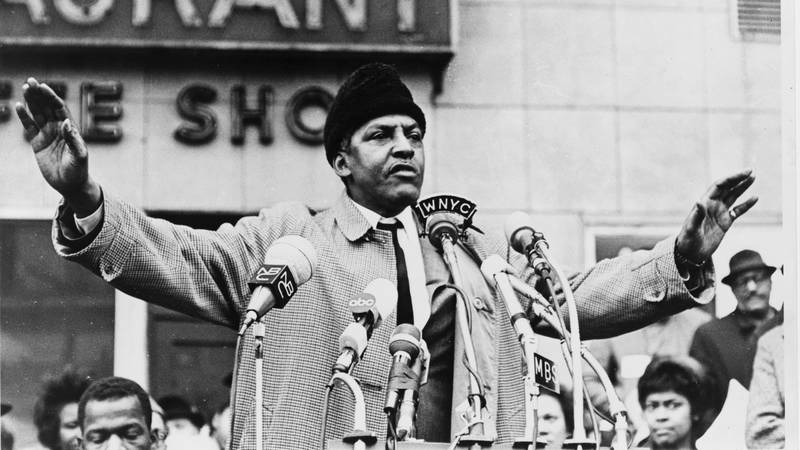Students connect virtually with their history at Stonewall through NPCA Zoom programs.
Over the past few years, chattering young people strolling down Christopher Street have tended to quiet down when they get to the Stonewall Inn. There’s the handsome brick façade, the old-fashioned sconces on either side of the door, the historic plaque. Something momentous happened here: an extraordinary uprising in 1969 that became the flashpoint in the modern gay rights movement. They have arrived at the Stonewall National Monument.
This is also a working bar, with a jaunty red neon sign and rainbow flags. These students, members of their schools’ GSA (gay straight alliance/gender sexuality alliance) clubs, are not there to imbibe, of course. They are on a field trip to learn more about the country’s first national park site dedicated to LGBTQ people. Program leaders from NPCA are waiting for them, ready to tell an important part of American history — the story of how patrons of the Stonewall Inn fought back against police raids and discrimination in a key turning point in the history of the LGBTQ civil rights movement in the United States.
Six years ago, NPCA launched the campaign to create a national monument at Stonewall that would honor this struggle for LGBTQ civil rights and add an unrepresented part of the country’s history to the National Park System. In 2016, President Obama designated Stonewall National Monument — which encompasses the Stonewall Inn and Christopher Park across the street — to tell the story of the struggle of the LGBTQ community and better reflect the breadth of the American experience.
“The riots became protests. The protests became a movement. The movement became part of America,” President Obama said.

Erased by History: The Seldom-Told Stories at 6 Nationally Significant Sites
Black LGBTQ people have long made history in America. Why don’t we know the names of these people and places?
See more ›Thanks to organizing by NPCA and coordination with the New York City Department of Education and the National Park Service, nearly a thousand New York City high school students have visited Stonewall National Monument. The tours start up after school, with the students gathering in a room above the Stonewall Inn. They hear about the history of Stonewall and the LGBTQ struggle for human and civil rights from National Park Service rangers while snacking on pizza and meeting fellow GSA cohorts from other schools. Then they troop downstairs and gather outside around the rangers in Christopher Park, where the 1969 uprising started, for more moving stories.
“It’s okay for us to be who we are,” said a National Park Service ranger, telling the students the story of the Stonewall uprising in the summer of 1969, when patrons of the bar fought back against one too many police raids, and a powerful LGBTQ rights movement was born.
“Our Pride Club started just this year, and to be able to come here and meet other kids going through similar things at one of the biggest places in gay history means the world to me,” said Javy Polanco from WHEELS (Washington Heights Expeditionary Learning School). “Learning about history is awesome, and to have a monument that’s just for our history is even better.”
More recently in 2020, due to social distancing restrictions during the coronavirus pandemic, hundreds more students, from a total of 108 different middle schools and high schools in all five boroughs, have participated in virtual tours, replacing the in-person visits. The success of these interactive online presentations, produced quickly by NPCA staffers as the pandemic shut down most day-to-day activity, shows how important it is to engage young people in this vital part of LGBTQ history.
Linking to current-day themes, the 2020 NPCA Stonewall presentation on Zoom includes comparisons of the Stonewall uprising to Black Lives Matter protests. Students’ reactions are heartfelt, ranging from amazement at the stories and photographs that chronicle the courage of those first protesters at Stonewall 51 years ago, to gratitude that Stonewall exists and deep appreciation for all that it stands for.
Online and in person, the Stonewall presentations usually begin with some myth busting. There’s no stone wall at the Stonewall Inn, the NPCA leaders tell the students, and it’s not an inn.
Many students confess that they really don’t know much about the history of Stonewall. NPCA leaders begin to tell the story: Not that long ago, laws discriminated against gender nonconforming people and prohibited bars from serving alcohol to LGBTQ patrons. The few places where LGBTQ people could gather, like the Stonewall Inn, were popular, though illegal. They were also constant targets of the police. In June 1969, the violent confrontation between the police and the gay patrons of the Stonewall Inn lasted six nights with increasing numbers of protesters. The following year, the uprising sparked hundreds of new LGBTQ advocacy groups and the first gay pride parades around the country, and the worldwide movement for equal rights gained a powerful foothold.
The friendly online presentations by NPCA staffers invariably lead to a great give-and-take with students, in person and online. With parallels to today’s Black Lives Matter protests inescapable, NPCA Program Manager Sergio Moncada helps to draw out workshop participants’ comments on the two movements, some of them profound. “Nobody’s free unless we’re all free,” one student notes.

The Park at the Heart of World Pride
New York City’s Stonewall National Monument commemorates 50 years of history this week as NPCA and our supporters continue to explore preserving important sites in LGBTQ history.
See more ›Moncada asks another question that draws spirited response: “Comparing the early gay rights protests with today’s Black Lives Matter protests, do you think social media helps or hurts the call for justice?”
At one Stonewall workshop via Zoom in early June, the start of Pride month, thoughtful responses flew in. “It makes it easier for people to feel like they’re doing something by just sharing an image and not doing anything otherwise. Therefore, it hurts,” one student said.
“It helps us organize faster and larger, but it makes it easier for our enemies to target us,” noted another.
“It can help connect disenfranchised people who may live in a less supportive part of the world,” said a third.
NPCA Program Coordinator Timothy Leonard responded with encouragement. “It’s interesting to see where peaceful protest spills over into action, because people feel they haven’t been heard,” he told the group, echoing the message of Dr. Martin Luther King, Jr., who famously said, “A riot is the language of the unheard.” In the case of Stonewall, 51 years ago, the nation had failed to hear that life for LGBTQ people had become unbearable.
Stay On Top of News
Our email newsletter shares the latest on parks.
Leonard invited students to visit the Stonewall National Monument in person, once pandemic restrictions are lifted, and promised to send all participants a document with links to a self-guided walking tour of Stonewall and a timeline of LGBTQ history in the context of American history. “We at NPCA want to make sure that people’s stories or voices that aren’t heard are part of the conversation,” he said.
In the end, that is the overarching goal of the NPCA youth tours and workshops at Stonewall National Monument. NPCA and the National Park Service strive to tell the stories of all Americans. As LGBTQ history continues to be made and the struggle for civil rights for all people goes on, NPCA is working to expand its Stonewall National Monument programs for young people, to empower them and connect them to this compelling symbol of community, heritage and freedom.
About the author
-
 Alison Simko Contributor
Alison Simko ContributorAlison Simko is a freelance writer for NPCA's Northeast Regional Field Office.
-
General
-
- NPCA Region:
- Northeast